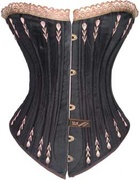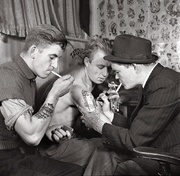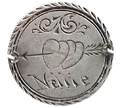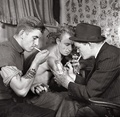
Two scrimshaw “whalebone” busks from the early 1800s housed at the Winterthur Museum in Delaware. (Via Winterthur.org)
We like to think of people in the 1800s as fusty prudes who were scandalized by the sight of an ankle. So it might surprise you to learn that in the early 19th century—long before Frederick’s of Hollywood or Victoria’s Secret—a young man in Europe or America might give his sweetheart a token of love she could wear inside her corset. Known as a busk, this long, flat, rigid object would slide into a tall, narrow pocket in the front of a corset between a woman’s breasts, all the way down to her pubic bone. Then, it would be tied into place to give the bust lift and help keep the corset straight and upright. Busks ranged from 10 to 16 inches in length, the longest of which would make sitting impossible for most women.
“She could wear it in her corset, where it would be a constant reminder of his love—probably because it was uncomfortable.”
A man would inscribe the busk with coded sentimental images for his beloved, and sometimes words, the idea being that these thoughts of love would stay close to her heart. But likely the thought of its proximity to her undergarments—and therefore, her naked body—gave the gift a sense of physical as much as emotional intimacy. According to Two Nerdy History Girls, a metal busk worn by French princess Anne-Marie-Louise d’Orleans, Duchesse de Montpensier was inscribed with, “How I envy you the happiness that is yours, resting softly on her ivory white breast. Let us divide between us, if you please, this glory. You will be here the day and I shall be there the night.”
From the 17th through the 19th century, corsets, known as “stays,” would often be lined with baleen, which came from the upper jaw of baleen whales. Made of keratin, the material that also forms fingernails and horns, a structure of baleen bristles served as a filter for the whales’ food. This boning gave the stay its V-shaped structure, and the lady wearing it would telegraph her virtue with her “upright” posture. To add rigidity to the already stiff corset, or a corset without boning, a busk could be carved out of wood, metal, baleen—mistakenly called “whalebone”—and sometimes the ivory from the teeth of sperm whales, which didn’t have any baleen, as well as skeletal whale bone and walrus-tusk ivory. These love tokens would be worn on special occasions only.

Scrimshaw busk and detail that shows whaling ships sailing into port. (From the Charles Whipple Greene Museum in Warren, Rhode Island, via the New Bedford Whaling Museum Blog)
Although whaling has been practiced around the world for more than 4,000 years, it wasn’t until the 15th century that whaling spread throughout Northern Europe. Whales, it was discovered, provided the ideal material for pre-electric lighting. Whale blubber would be boiled to create whale oil, which grew in demand because it fueled oil lamps with less smoke and odor than canola oil, bees wax, or animal tallow. Another oil, known as spermaceti because it’s found in the head of sperm whales, was coveted for lamps and candles, because it produced a bright, clear flame with little smoke. Soon whale products were fueling lighthouses and street lamps.
During the 17th century, whale oil became more valuable than whale bones, ivory, and baleen, which weighed down the ships and were typically discarded. In the mid-18th century, the invention of clocks that could keep time in the tumultuous ocean allowed captains to navigate longer journeys. The whaling industry exploded, as Europeans and Americans took lengthy voyages with enormous crews to hunt these great mammals to the ends of the earth. Sailors—especially artisans like the ship’s carpenter and cooper—started to save bits of whale ivory, bone, and baleen, the discarded “hard byproducts,” which they would carve into tools and other useful objects. In the early 19th century, sailors, looking for a way to amuse themselves during the long days at sea, began engraving decorations into whale’s teeth and into their hand-carved tools made out of ivory, bone, and baleen. This folk-art technique became known as “scrimshaw.”
Teeth from sperm whales, for example, would be polished and engraved. The engraving would then be filled with a black pigment known as “lampblack,” a carbon-filled oil residue found in oil lamps and the ship’s tryworks, the cast-iron pots in a furnace where blubber was turned to oil. Colored pigments were also made from the green verdigris deposits found on copper and brass, as well as from fruits and vegetables; other sailors brought store-bought inks with them. Some pieces were carved and forged into walking sticks, yarn-winders known as “swifts,” kitchen utensils like pie crimpers, sewing boxes, and of course, busks. Although seafaring had a long tradition of banning women from ships, in the 19th century, sometimes wives and children of captains joined the men on the ship, and practiced these scrimshaw crafts as well.

An example of a corset with a pocket for a busk at the 2012 “Underneath It All” exhibition at the Missouri History Museum in St. Louis. (Photo courtesy of Nancy Rosin)
More often, though, sailor’s sweethearts would stay at home, waiting for their beloved to return. In the early 1800s, a young man desperate for money and looking for adventure could join the crew of a whaling ship and be out to sea for as many as 3 or 4 years in a row. And when he came home to his beloved, he’d better not return empty-handed. With all his free time and free material, he could make her something useful that she might not be able to afford, like an elaborate yarn winder, a pie crimper, or a corset busk.
“It’s estimated that nearly 236,000 whales were killed in the 19th century alone.”
“The whole concept was to give your loved one a memento, some tangible thing that she could wear or use,” says Nancy Rosin, the president of the National Valentine Collectors Association, who has 38 scrimshaw busks in her collection. “A woman would use something like a pie crimper often, and every time she used it, she would remember her sailor. Busks were huge tokens of love. She could wear it in her corset, where it would be a constant reminder of his love—probably because it was uncomfortable.”
Scrimshaw busks would be engraved with all sorts of symbolic images: A palm frond might indicate a place the whaleman had sailed to, while a North Star would assure the woman that her man would be guided home. Wheat stalks stood for abundance, houses meant security and comfort, and a church indicated plans for marriage. All of these hopes and dreams would be pressing into her torso throughout the day.

A scrimshaw “whalebone” busk housed at the Smithsonian Institute’s “On the Water” collection features a cityscape on the front and a love poem on the back. (Via americanhistory.si.edu)
“Back then, any sailor who went off to sea didn’t know if he was ever going to come back,” Rosin explains, whether he was fighting in a war, or joining a merchant crew or whaling ship. At the peak of the whaling industry in the mid-1800s, traumatized whales started attacking ships, adding another danger to an already dangerous occupation. “So the sailor’s farewell is a popular scene in valentines and makes up a big part of my collection. I have engravings, lithographs, even broadsides that feature ballads like, ‘The Sailor’s Tear.’ The imagery always shows the man going off in the ship, with Cupid in the trees, aiming his arrows.”
According to io9, “it’s estimated that nearly 236,000 whales were killed in the 19th century alone.” Whaling ships had to go on longer and longer voyages to colder and rougher waters to hunt down the coveted and increasingly expensive oil, as sperm whales were on the brink of extinction by 1846. People started to turn to burning alcohol, which was much cheaper. In 1849, a Canadian geologist Abraham Gesner discovered how to produce kerosene oil from petroleum, and when alcohol was taxed during the American Civil War in 1861, kerosene became the fuel of choice.
The most celebrated novel ever written about whaling, Moby-Dick, or The Whale, by Herman Melville, wasn’t published until 1851, just as the American whaling industry was having its last frenzied gasp. The number of U.S. whaling ships peaked at 199 in 1858, and dropped to 105 by 1866 and 39 in 1876. Melville, who’d sailed on a whaling ship as a young man in 1840, captured the hours of boredom at sea and the grueling, life-threatening work on board, as well as the mythology of a seemingly unkillable white whale who attacked and sunk ships.

Two “whalebone” scrimshaw busks. At left, a 10.25-inch example from the mid-19th century features a heart, shield with plants, geometric forms with foliate designs and arrows, potted tree with American flags, and five-pointed star at the bottom. At right, an 11-inch 1840 busk carved by a sailor includes a sunrise, ship, house, table with beverages, mother with child, and windmill. (Both via Eldred’s Auctions)
In the mid-19th century, corsets also changed, and metal was used for the boning instead of whale parts: Busks were now made with two long pieces of steel with hook-and-eye fastenings, which made dressing and undressing much easier for women. The spoon busk, invented in 1879, gave the steel busk a wide dish at the bottom for greater control of the belly. No longer would a hand-engraved baleen or whale ivory busk be a sexy, romantic gift. In the 1920s, corsets were replaced with boning-free elastic girdles.
“Back then, any sailor who went off to sea didn’t know if he was ever going to come back.”
By the 1930s, the whaling industry had all but died out in the United States. After World War II, representatives from seven countries came together to form the International Whaling Convention to manage the whaling industry and preserve whale populations. In 1972, a year before the Endangered Species Act, the U.S. Congress passed the Marine Mammal Protection Act, which made it illegal to kill or injure all marine mammals or import products, like busks, made from these animals. In 1986, the IWC banned commercial whaling, a rule countries like Japan and Norway have ignored.
That’s why these scrimshaw busks are so haunting: They’re reminders of a time when whales suffered and nearly went extinct, when young men risked their lives for lamp fuel, and the women left behind wondered if the most intimate dreams etched into baleen would ever come true.
(Recommended reading: To learn more about baleen and busks in corsets, check out Two Nerdy History Girls’ article “The Essential Busk, Whether for Bodies, Stays, or Corset”; Slate’s “Well-Rounded: A history of corsetry, from whalebone to Lycra”; National Trust: The Hidden Wardrobe’s “Stays; walls of defence about a lady’s shape…”; and Valerie Steele’s book “The Corset: A Cultural History.” To learn more about scrimshaw art, check out Marlene Youle’s collection of scrimshaw images on Pinterest and pick up Norm Flayderman’s book, “Scrimshaw and Scrimshanders: Whales and Whalemen.” To learn more about whaling in general, read io9’s article “1846: The Year We Hit Peak Sperm Whale Oil”; the New Bedford Whaling Museum’s “Art of Whaling”; About.com’s “What Products Were Produced From Whales?”; National Geographic’s “Big Fish: A Brief History of Whaling”; and EnvironmentalHistory.org’s “The whale oil myth.” If you buy something through a link in this article, Collectors Weekly may get a share of the sale. Learn more.)









 Darling, Can You Spare a Dime? How Victorians Fell in Love With Pocket Change
Darling, Can You Spare a Dime? How Victorians Fell in Love With Pocket Change
 Everything You Know About Corsets Is False
Everything You Know About Corsets Is False Darling, Can You Spare a Dime? How Victorians Fell in Love With Pocket Change
Darling, Can You Spare a Dime? How Victorians Fell in Love With Pocket Change Hello Sailor! The Nautical Roots of Popular Tattoos
Hello Sailor! The Nautical Roots of Popular Tattoos ScrimshawEuropeans first took to the sea to hunt whales in medieval times. The fatty…
ScrimshawEuropeans first took to the sea to hunt whales in medieval times. The fatty… Victorian Era ClothingThe Victorian period ran from 1837 to 1901 and is named for Queen Victoria,…
Victorian Era ClothingThe Victorian period ran from 1837 to 1901 and is named for Queen Victoria,… Womens Clothing“Clothes make the man,” said Mark Twain. “Naked people have little or no in…
Womens Clothing“Clothes make the man,” said Mark Twain. “Naked people have little or no in… Mari Tepper: Laying it on the Line
Mari Tepper: Laying it on the Line Nice Ice: Valerie Hammond on the Genteel Charm of Vintage Canadian Costume Jewelry
Nice Ice: Valerie Hammond on the Genteel Charm of Vintage Canadian Costume Jewelry How Jim Heimann Got Crazy for California Architecture
How Jim Heimann Got Crazy for California Architecture Modernist Man: Jock Peters May Be the Most Influential Architect You've Never Heard Of
Modernist Man: Jock Peters May Be the Most Influential Architect You've Never Heard Of Meet Cute: Were Kokeshi Dolls the Models for Hello Kitty, Pokemon, and Be@rbrick?
Meet Cute: Were Kokeshi Dolls the Models for Hello Kitty, Pokemon, and Be@rbrick? When the King of Comedy Posters Set His Surreal Sights on the World of Rock 'n' Roll
When the King of Comedy Posters Set His Surreal Sights on the World of Rock 'n' Roll How One Artist Makes New Art From Old Coloring Books and Found Photos
How One Artist Makes New Art From Old Coloring Books and Found Photos Say Cheese! How Bad Photography Has Changed Our Definition of Good Pictures
Say Cheese! How Bad Photography Has Changed Our Definition of Good Pictures Middle Earthenware: One Family's Quest to Reclaim Its Place in British Pottery History
Middle Earthenware: One Family's Quest to Reclaim Its Place in British Pottery History Fancy Fowl: How an Evil Sea Captain and a Beloved Queen Made the World Crave KFC
Fancy Fowl: How an Evil Sea Captain and a Beloved Queen Made the World Crave KFC
As a side note, the term “stays” refers both to a whalebone-stiffened undergarment and the standing rigging that supports the masts on a sailing vessel.
Thank you for this article! However I would like to make a correction. The Scrimshaw busks shown in this article are made out of whalebone, not baleen. Baleen is flexible and normally dark brown with ridges in it. These are whale bone or whale ivory.